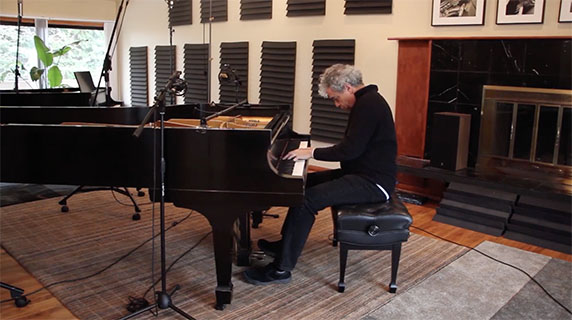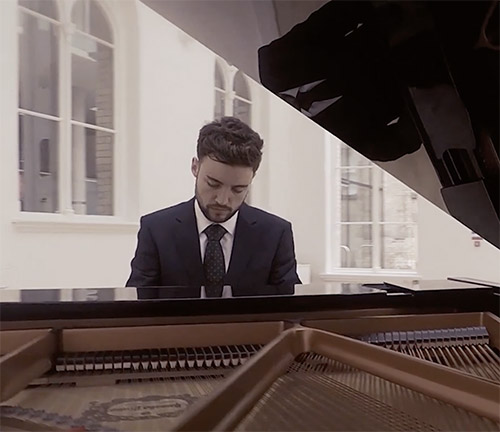
Jovino Santos Neto
Three-time Latin Grammy nominee Jovino Santos Neto, a master pianist, composer and arranger, is among the top Brazilian musicians working today.
Live Seminar Resources
Live Seminar Resources
PDF Downloads
- Campinas Lead Sheet
Join PianoGroove Pro to access all downloads and learning resources.
Download theory supplements, midi files, chord changes and full note-for-note transcriptions of every lesson.
- Infant Eyes Lead Sheet
Join PianoGroove Pro to access all downloads and learning resources.
Download theory supplements, midi files, chord changes and full note-for-note transcriptions of every lesson.
Seminar Description
Seminar Description
Playing Jazz Ballads – Expressive Techniques & Improvisation
Welcome to this in-depth lesson on playing jazz ballads with emotion, phrasing, and harmonic depth. In this session, we explore key techniques to bring out the expressive qualities of ballads while focusing on two compositions: "Infant Eyes" by Wayne Shorter and "Campinas" by Hermeto Pascoal.
The Essence of Playing Ballads
Ballads in jazz, Brazilian, and classical styles share a common characteristic – they are slow, expressive, and deeply emotional. The word "ballad" itself originates from the French "ballade," meaning a leisurely walk, which reflects the relaxed and flowing nature of these pieces. Whether romantic, nostalgic, or introspective, ballads require a delicate touch and an understanding of space, phrasing, and interpretation.
Avoiding the Temptation of Double Time
One of the key challenges when playing ballads is resisting the urge to play them in double time. Ballads often sit in a tempo range between 60-75 BPM, allowing for expressive phrasing and dynamic control. If rushed, the natural flow and breathing room of the melody and harmony are lost. Instead of feeling the pulse as a rigid beat, approach it as a gentle wave that guides the phrasing.
Expressive Interpretation of Melody
In jazz, the melody written on a lead sheet is often just a guideline rather than a strict rule. Playing it exactly as written can sound mechanical. Instead, focus on:
- Phrasing – Adding subtle rhythmic flexibility to mimic vocal phrasing.
- Articulation – Using legato, staccato, and dynamic variation to shape the melody.
- Expression – Leaving space between notes to let the music breathe.
For instance, in "Infant Eyes," the melody naturally intertwines with the harmony, making it essential to shape each phrase thoughtfully.
Harmonic Exploration & Voicing Choices
Accompanying with Rich Chord Voicings
When learning a new ballad, it’s useful to start by exploring the accompaniment first before adding the melody. This approach allows you to internalize the harmonic framework and create a supportive atmosphere for the melody.
A few key voicing techniques for ballads:
- Spread Voicings – Spreading chord tones across both hands for a balanced sound.
- Rootless Voicings – Allowing bass players (or the left hand) to outline the harmony while keeping the right hand free for color tones.
- Suspended Chords & Extensions – Using 9ths, 11ths, and 13ths to create richer harmonic textures.
A standout example is the A13b9 chord in "Infant Eyes," which can be voiced by playing an F#maj triad over an A7 shell voicing. This creates a smooth harmonic connection to the next chord, Gbmaj7, through a chromatic voice-leading technique.
Improvisation Concepts for Ballads
Telling a Story Through Improvisation
Improvising over ballads requires a lyrical approach, much like telling a story. Rather than relying on fast scalar runs, focus on:
- Motivic Development – Repeating and slightly altering small melodic ideas.
- Use of Space – The notes you don’t play are as important as the ones you do.
- Chord Tones & Arpeggios – Outlining harmonies in a way that flows naturally.
In both "Infant Eyes" and "Campinas," the harmonic structure offers multiple pathways for melodic expression, allowing for smooth, interconnected improvisation rather than rigid scale-based playing.
The Rhythm & Feel of a Ballad
Adding a Gentle "Lift" to the Pulse
Ballads do not always have to feel like a straight quarter-note pulse. To maintain a sense of forward motion without rushing, consider incorporating a three-three-two feel:
- Instead of counting 1, 2, 3, 4, internalize a slight rhythmic push:
1-2-3, 1-2-3, 1-2
This subtle rhythmic lift prevents the ballad from feeling too static and adds momentum while preserving its slow tempo.
Practice Tips
- Start with Voicings First – Before playing the melody, explore different ways to voice the chords to internalize the harmonic movement.
- Resist Double Time Playing – Keep the phrasing open and fluid, avoiding a rushed interpretation.
- Improvise with Space & Dynamics – Focus on telling a story rather than filling every beat with notes.
- Use Non-Root-Based Voicings – Expand your harmonic palette by avoiding roots in the melody and improvisation.
- Emphasize Phrasing & Expression – Treat the melody as a vocal line, shaping it with natural rises and falls in intensity.
By applying these techniques, you will develop a deeper emotional connection to ballads and enhance your ability to play them with sensitivity and depth. Keep exploring different voicings, phrasing, and improvisational approaches to make each performance uniquely your own.








Wonderful! Thank you Jovino. I’d not heard Infant Eyes before, such beautiful chords. I’ll be practicing this one.
Hi John,
I have just added the blue light-up keyboard so it’s easier to review Jovino’s voicings.
Enjoy!
Cheers,
Hayden
Wonderful, thank you Hayden. My project for June!
Thank you Hayden,
Jovino is amazing. If people haven’t seen his Tiny Desk performance for NPR
they really should. It’s fantastic!!
Cheers and thank you both.
Brian
Hi Brian,
Thanks for sharing the video – I agree it’s a wonderful performance and yes we are lucky to have Jovino on our teaching team!
If you are ever in the Seattle area Jovino performs regularly with his quinteto and his shows are always awesome.
Cheers,
Hayden